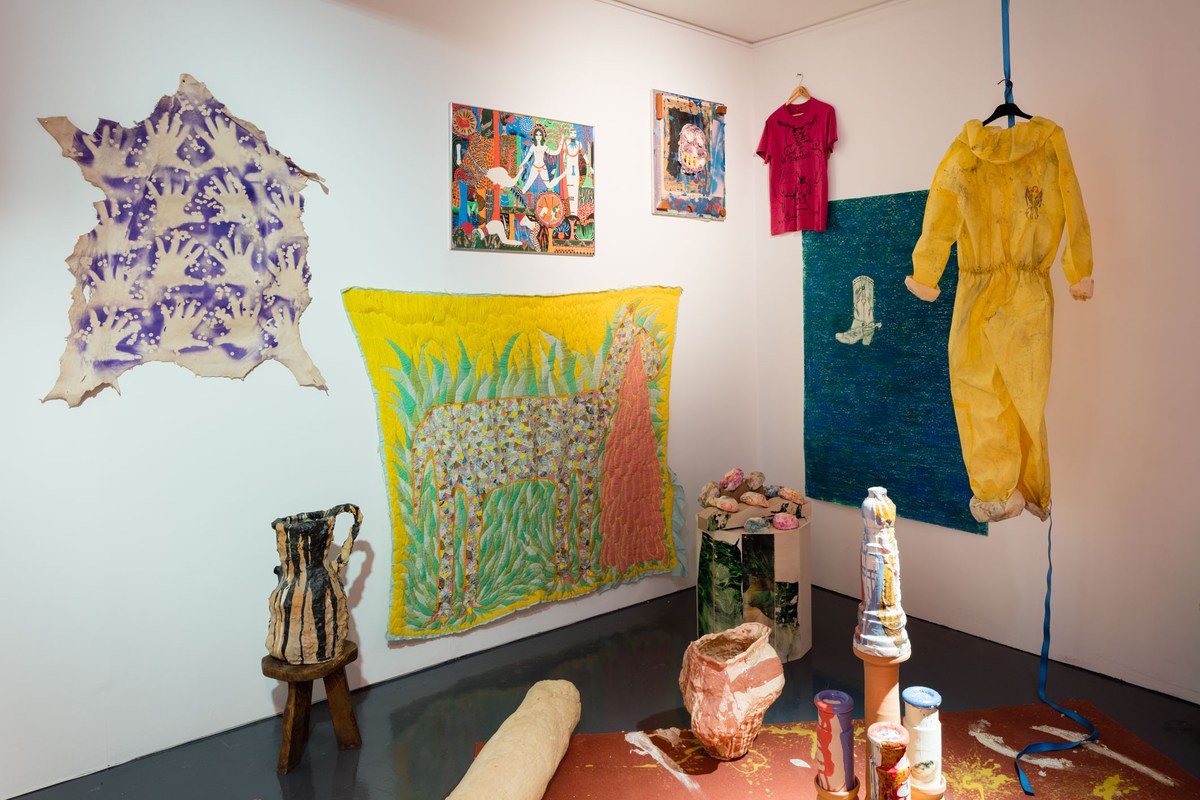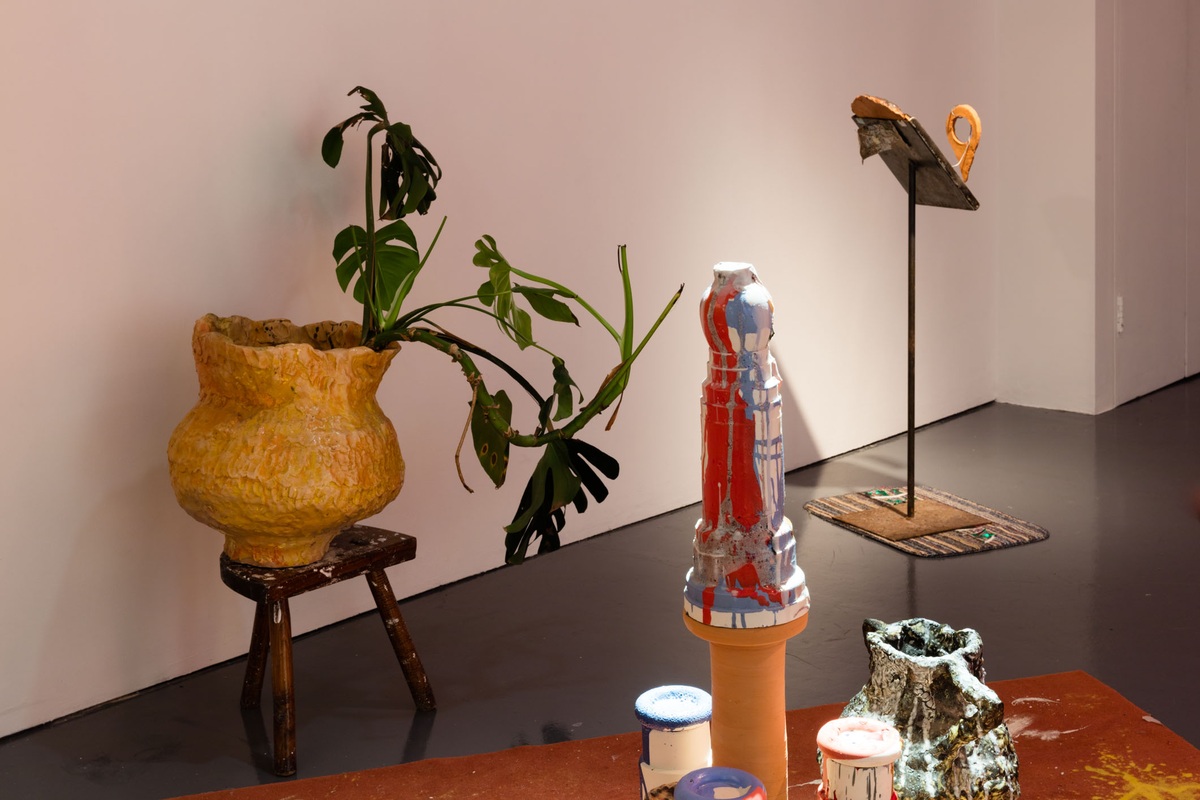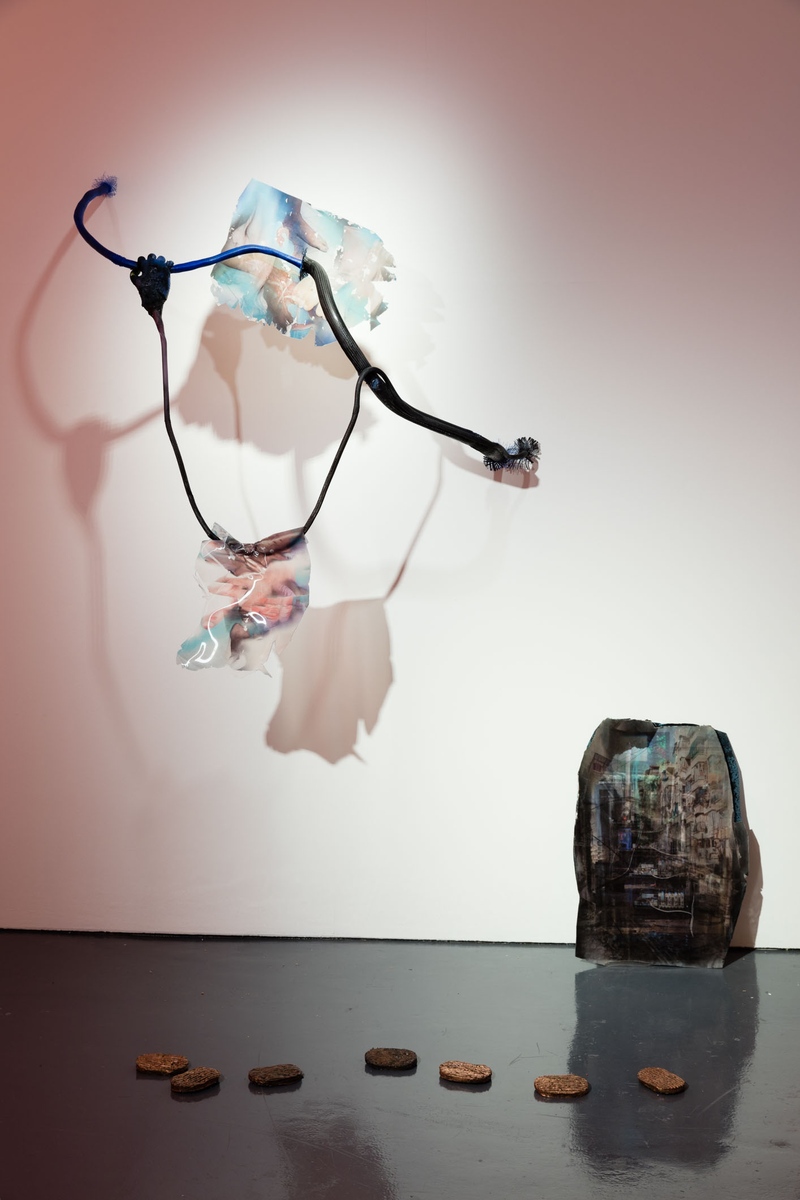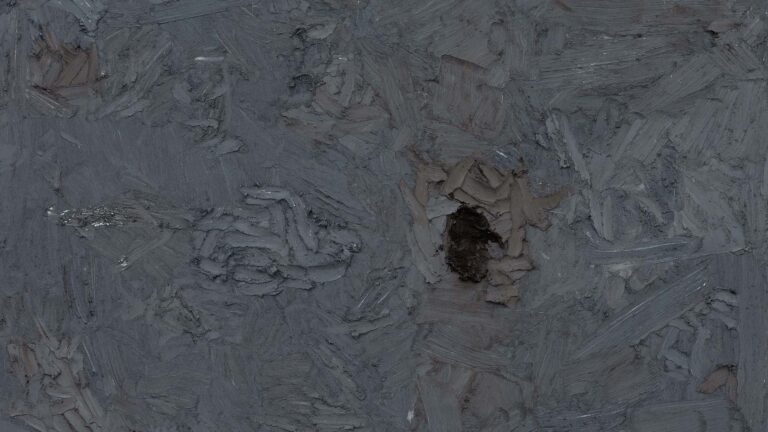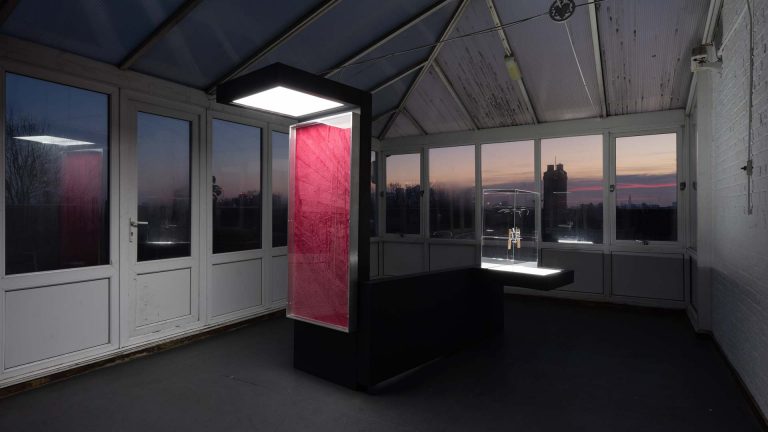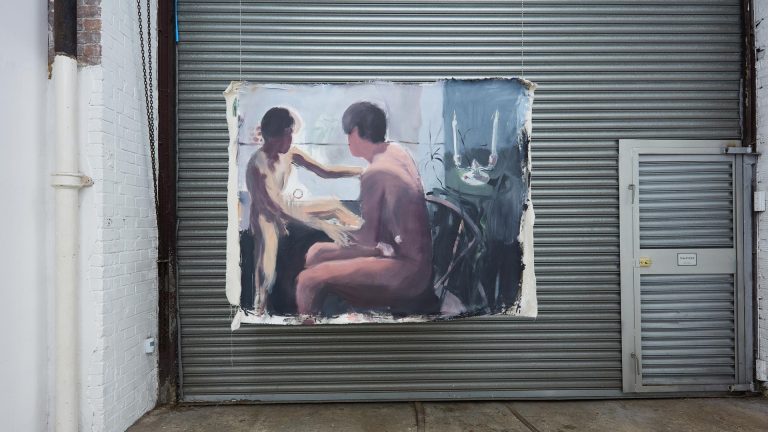Artists: Lupo Borgonovo, RJJ Carron, GCC, Dorothy Iannone, Estrid Lutz & Emile Mold, Gabriel Méo, Matteo Nasini, Athena Papadopoulos, Aurora Pellizzi, Octave Rimbert-Rivière, Robert Rush
Exhibition title: From Transhuman to South Perspectives
Curated by: Charlotte Cosson and Emmanuelle Luciani
Venue: Rowing, London, UK
Date: April 9 – May 14, 2016
Photography: Plastiques, all images copyright and courtesy of the artists and Rowing, London
ARTWORKS AS FORMAL CRYSTALLIZATIONS OF POSSIBLE FUTURES
There are many different definitions of what works of art are. From our viewpoint, artworks are formal crystallizations of social shifts. Most of these concretions match the specifics of neoliberalism, our postmodern condition: ready made consumer goods and works of art using expressive marks as if they were signs cut from their history, as if they were logos… Yet, within Art, underground forces always offer a glimpse of different possible futures – futures contradicting our society’s current stasis.
TRANSHUMANISM
If one believes the “gang of four” Google, Amazon, Facebook, and Apple, the logical evolution of our society appears to be toward making science-fiction a reality. From out of this genre of speculative fiction, “transhumanism” is born. As a philosophy, transhumanism seeks to overtake the limits of mortality through biotechnology and technology. Disability, death, and aging would all be made obsolete by a life lived online, or by altering our genes. Laurent Alexandre, the surgeon who created the “Doctissimo” website, proposes that Google’s ultimate goal is to merge the brain with silica: supercharging the neurons by combining them with robotics. Moreover, Ray Kurzweil, Director of Engineering at Google and cofounder of Singularity University, predicts that life expectancy will increase by 20 years by 2035.
A CEREBRUM-DICTATORSHIP
This man-machine fusion is apparent in Unbroken fingers by Estrid Lutz & Emile Mold: hands suspended from cables affixed with melted lenticular screens, perhaps portraying doubts about a future where people have unequal access to technological immortality. GCC’s video Co-Op offers a different perspective on the world’s possible evolution. Following on assumptions of modernisation’s constant march forward and exponential economic growth, the work emphasizes the pervasive use of architecture from which all vernacular details have been erased, depicting an unidentifiable environment. The GCC collective imagines the heyday of prosperity dominated by publicity. Differences between men and women are blurred, as with transhumanism which could help close the gender gap by offering the possibility of choosing every aspect of one’s own life. Yet, within these two differing works, underlies a similar dictatorial dimension… And Laurent Alexandre recalls that a dictatorship on the brain would be unconquerable.
CAPITALISM AT ITS VERY PEAK
Transhumanism corresponds to capitalism at its very peak; the collapsing together of the Internet of Things and humans as information. However, capitalism is the only model that isn’t destabilized by criticism because it has been accepted as the only viable alternative against totalitarism. This belief has led to the idea of the “end of History,” which emerged following the fall of the communist bloc in the 1990’s. The End represented to some the ultimate victory of the liberal West. Merging our current political situation with a cerebrum-dictatorship would ultimately ratify this perceived victory.
THE ISSUE OF BEING UPROOTED
The perceptions of French duo Estrid Lutz & Emile Mold, together with GCC, from the Gulf states, can be explained by a shift in context. The Arab world is in a phase of accelerated urban growth, while the Old Western World realizes it has potentially reached the limits of its power after cutting loose from its roots. The disappearance of any concrete, historical background is apparent in the crafty financial speculations being produced today, which themselves are devoid of any relation to financial reality. As it relates to certain contemporary art works, the idea corresponds the notion of “radicant,” or without roots. However, even if it is possible that the Western World is reaching “the end of the end of History”; the very idea of transhumanism could overcome even bigger polarisations. For example, transhuman theories reach beyond Left/Right political debates, opening up a productive new space between “bioconservatives” and transhumanists.
Within the transhuman framework, we talk about “improved humans.” However will we not experience the twilight of our civilisation once humans and robotics become fused together? Athena Papadopoulos’ piece, hanging like strips of ragged, disembodied flesh, appears to confirm this hypothesis. Observing the works, customs, philosophy and economy, it is apparent that we are in the dusk of a system – that we have reached the end of a cycle. But should we detect in those signs the end our society or the end of our civilisation?
RENAISSANCE ERA AND CAPITALISM
Since the 15th century, humanist thinking has placed Man, as an autonomous and cultivated being, at the centre of the world. By putting the human – and not God – at the beginning of everything, it has paved the way for the emergence of a new era that would take place of the feudal system: the Renaissance era. The modern world was born: gradually, individualism, the bourgeoisie, the market economy and the separation of work and capital have shaped the society we know. These are the foundations being challenged by those for who transhumanism is not the only possible path. Indeed, centralising, outsourcing, manufactured productions, the bulletproof separation between artists and craftsmen – traits of the Modern World – seem out-dated by a growing portion of the contemporary art world.
NATURE / CULTURE and CAPITALOCENE
Bruno Latour reminds us that separation is at the heart of modernity. Yet, he believes, the clear distinction between the scientific and political is fictional. Therefore, the same distinction between Nature and Culture seems, by definition, false. On the broader scale, man was born within Nature and as part of the food chain; this is indeed what is conjured up in Dorothy Iannone’s Flora And Fauna, where human beings, animals and plants are shown interacting on an equal footing, in a stylistic harmony. If modern culture has separated Nature and Culture, it was because Mankind stopped participating in Nature’s balance and turned into a disruptive element… This is ultimately what is referred to today as the Anthropocene era: an age in which Mankind has had such an impact on the ecosystem that its actions have started altering it, often for the worse. Matteo Nasini’s tearful quadruped atop a hand-woven blanket would not disagree. But shouldn’t we stop talking about “Anthropocene”, as if the whole of Humanity is participating in this entropic mechanism? Indeed, we could doubt the Amazonians’ contribution to our planet’s destruction to benefit financial deregulation. Let’s instead change this word into “Capitalocene”.
ANIMISM/SHAMANISM for a renewed COEXISTENCE
The idea of a more harmonious relation between animals, humans and objects is not solely rooted in object-oriented philosophies or stemming from speculative materialism. Animism has been preaching such equality from time immemorial. This particular way of seeing the world relates most of the time to shamanism – whose meaning is explored through travels amid the different layers of reality and traditional medicine. Hence, how should we grasp these totems which materialise in contemporary production, such as Gabriel Méo’s bizarre sculpture welcoming us inside the exhibition, and Aurora Pelizzi’s tanned animal hide, composed of organic material.
RELATING TO A COMMON HISTORY
From these ancestral signs comes a subtle yearning to reach out for a joint human history; a History existed before monotheistic religions and the hatred developed between them. Let’s remember, animism and shamanism are not religions; they are visions of the world that relate with others, by peacefully coexisting with dignity and respect to history, humbly aspiring to dream the future. With the irruption of shamanism in art, a renewed interest in the universal can be observed across a variety of cultures. Going back to feudal, or even earlier to ancestral production methods is another sign of the same movement in contemporary art. Far from the manufactured goods of the modern and post-modern age, which are mocked by the handcrafted bronze “frozen” steaks and ceramics pastries of Octave Rimbert-Rivière, contemporary creations are renewed with craftsmanship. Pottery and textiles proliferate. By using ceramics and weaving, young artists re-engage with the world’s oldest crafts – and thus with the very roots of humanity.
PRECAPITALIST PRODUCTION METHODS
When weaving or moulding with their own labour, contemporary artists are using precapitalist production methods. These crafts take time, reviving the idea of labour intensive and long efforts – and even meritocracy. Such intentions lie opposite to liberal consumerism, which markets the improvement of our daily lives to the point of eliminating any practical constraints. This point directly correlates with the Internet of Things whose purpose is to create services that can anticipate our desires before we even acknowledge them. On the other hand, Matteo Nasini’s Piango Rosa quilt required months to embroider, the work answering in substance French writer Nicolas Boileau’s poetic injunction: “Slowly make haste, without loosing heart / go back to your loom/craft twenty times more.” Yet, this pre and post-revolutionary poet was more attached to the norm than transgressing it, as well as having lived before the separation of fine arts and crafts during the 18th century. It would seem that this divorce is today being called into doubt.
Robert Rush, Gabriel Méo and Octave Rimbert-Rivière’s enamelled earthenwares unveil the human facet of these objects; an impossible “condition” to transpose through machine-made things. We are witnessing a return of the “touch”, subsequent to the 20th century where the signature and author where dismissed without being revived through craftsmanship. For the avant-gardists, machines and industry were the new gods. Handmade ceramics are thus a fresh contrast to A.I. The 21st century’s return to precapitalist production processes can only be in favour of going beyond the modern system, which began in the Renaissance era, and became widespread after the French revolution and globalized since the end of the last century.
WHEN THE ECONOMY INFLECTS A BROADER DISTRIBUTION
According to Japanese philosopher Yanagi Sōetsu, folk art is humbly produced by unnamed and unknown craftsmen for the functional daily use by the people. However, the need to reconnect with humanity’s roots can only arise from an art “for the people,” without becoming populist. Hence, Della Robia’s glazed ceramics were much more affordable than Brunelleschi’s sculptures. Therefore, already back in the 15th century, the economy determined the distribution. Likewise, the renewal of ceramic works in contemporary art enables a broader diffusion in society. This same accessibility and humility is tangible in the Marseille Local Business project by RJJ Carron. The duo collaborates with small homespun businesses in Marseille to distribute their trademark by creating tote bags, t-shirts and ceramics. This can be linked with the very idea of humility advocated by Sōetsu. Far from the huge installations and sculptures made in the 1990s’ when consumerism was at its peak, today are arising small, easily crafted and transportable items in line with the early 2000s financial crisis.
A broader distribution of art works is only possible if it is affordable to do, and therefore is oftentimes related to a desire to decentralize. Small scale production with little capital cannot correspond to the “megalopolis life”, a life leading to untenably high rents and moulded by urbanism. Centralization is typically a modern concept, unknown to the medieval era, nor ancestral civilizations. Within modernity, the Beat Generation writers had already proposed to escape the city in order to experiment with different forms of creativity, heading “West”, from New York to California. Might this be the philosophy quoted by Lupo Borgonovo’s hand drawn western boot?
PRODUCING EVEN IF SETTLING THE ENTROPIC BILL
The ready access to raw materials such as wool and soil minerals empowers an “art-crafting “that barely has to give in to the pressures of capitalism. Yet, this is not the only advantage to making ceramics or weaving. These crafts do not even require electricity to perform. An electrical shortage or more likely the next economical crash would not yet deprive the “art-craftsmen” of “From Transhuman to South Perspectives” from shaping, weaving, drawing, crafting, creating at will. To fathom how a simple fire can revive art, while our times will have to settle the outstanding entropic bill, is comforting.





